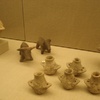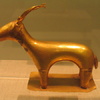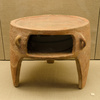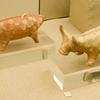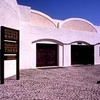Archaeological Museum of Thira
-
Museum of Prehistoric Thira
One of the most important museums of Greece is the spectacular Museum of Prehistoric Thira in Fira. The museum houses a very large number of findings from various excavations in Santorini, such as at Akrotiri, conducted under the auspices of the Archaeological Society at Athens, and at the nearby Potamos site, conducted by by members of the German Archaeological Institute at Athens and covers the island's history starting from the Late Neolithic period to the Late Cycladic I period.
The collections are ordered chronologically, and include ceramics, sculptures, jewellery, wall paintings, and ritual objects. Visitors can admire temporary exhibitions on the ground floor and four permanent exhibitions on the first floor, referring to the history of research at Thira, the geology of Thira, the island's history from the Late Neolithic to the Late Cycladic I period (early 17th century BC) and the heyday of the city at Akrotiri (mature Late Cycladic 1 period, 17th century BC).
In the last unit, various aspects are presented, such as the plan and architecture of the city and its organization as an urban centre, the emergent bureaucratic system, the development of the monumental art of wall painting, the rich and diverse pottery repertoire, the elegant jewellery, the reciprocal influences between vase painting and wall painting, and the city's and island's complex network of contacts with the outside word. The exhibits include fossils of plants that flourished before the human habitation of Thira as well as archaeological objects.
Among the Earliest Pieces are :- Neolithic pottery, Early Cycladic marble figurines, Early Cycladic pottery, including interesting pieces of the transitional phase from Late Cycladic II to Late Cycladic III period (Kastri group) from the Christiana islands and Akrotiri (3300-2000 BC)
- Middle Cycladic pottery with a series of impressive bird jugs, many of them decorated with swallows from Ftellos, Megalochori and Akrotiri (18th-20th century BC) Early Cycladic metal artefacts from the last two sites.
The Exhibition Endeavours to sketch The Course of Thira in Prehistoric Times
Noteworthy among the numerous exhibits from the period when the city at Akrotiri was at its zenith (17th century BC) are the plaster casts of furniture, the household equipment, the bronze vessels, tools and weapons, the objects that bear witness to the practice of metalworking, the sealings, seals and Linear A tablets. Impressive too are the magnificent wall painting ensembles (wall painting of Ladies and Papyri, wall painting of the Blue Monkeys) and fragments of others (the African, Adorant Monkeys, Bird, floral motifs).
Last, there are numerous and luxurious clay vases including the remarkable pithos with the bull, vases of stone and of clay imported from different parts of the Aegean and the Eastern Mediterranean, and the gold ibex figurine, a remarkable recent find. The exhibition endeavours to sketch the course of Thira in prehistoric times, through selected finds from the thousands in the storerooms. This was a dynamic and creative course which established the city at Akrotiri as one of the most important Aegean centers during the 18th & 17th centuries BC.

